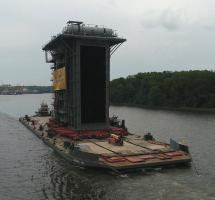 Rivers have always made the best highways. On Monday, a massive heat-recovery steam generator left the Port of Coeymans, near Albany, on the Hudson River, on a barge bound for a new power plant under construction in Sewaren, NJ. The generator weighs in at an impressive 4,000 short tons, is 130 feet tall and costs $195 million.
Rivers have always made the best highways. On Monday, a massive heat-recovery steam generator left the Port of Coeymans, near Albany, on the Hudson River, on a barge bound for a new power plant under construction in Sewaren, NJ. The generator weighs in at an impressive 4,000 short tons, is 130 feet tall and costs $195 million.
The generator was welded to the deck of a 400′ long deck barge with a 100′ beam and was taken under tow down the Hudson River. Once in New York harbor, the barge was towed up the Arthur Kill to Sewaren. The pace of the voyage was determined by the currents and several bridges, including the Mid-Hudson Bridge and the Arthur Kill Vertical Lift Bridge, which the generator could only pass under at low water.
The heat-recovery steam generator is a major component of a $600 million plant expected to open next year off Cliff Road in the Sewaren section of Woodbridge. As reported by NJ.com: Sewaren 7 will replace PSEG Power’s existing Sewaren Generating Station, replacing Units 1, 2, 3 and 4, which will be retired after nearly 70 years. It was badly damaged during Hurricane Sandy in 2012. The new plant will be a dual-fuel, 540-megawatt plant that will run primarily on natural gas but can also run on ultra low-sulfur distillate fuel oil as a backup fuel, according to information provided by the utility.
Massive Steam Generator Travels Down the Hudson River
Thanks to Ulrich Rudofsky for contributing to this post.

The Four Sewaren Steam Turbine Units had Rankine Cycle efficiencies of 41%.
Sewaren 7 a Combined Cycle Combustion Turbine, has an efficiency of 61%.
Since Electricity is a commodity item, 120 Volts, 60 Cycles, The older less efficient plants are being closed for economic reasons.
It’s amazing Thomas Edison’s Pearl Street Plant circa 1882 generated electricity for 12 cents a KW-HR.
Today electricity costs consumers the same amount..
How is this possible, while labor, fixed, and variable costs have all increased: The technology has gone from: Pearl Street’s Reciprocating Steam engine’s 7.5% efficiency on a good day, to today’s Combined Cycle Combustion Turbine, CCCT’s 61% efficiency.
Amazing!
Very interesting. Thanks.